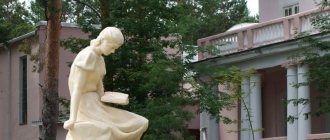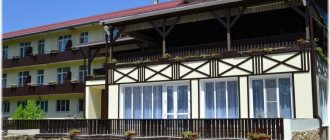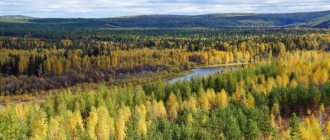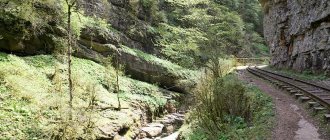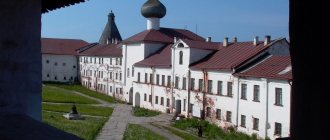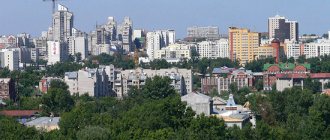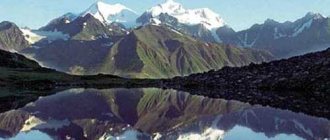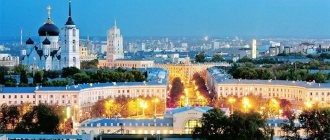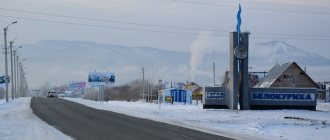Beloretsk against the backdrop of Raspberry Mountain
Sergey Sinenko
History of the city of Beloretsk (Bashkiria)
Beloretsky district is the largest in the republic. There is no end to it. Huge mountains, forests, stone pillars, mountain rivers, deposits of iron ore of rare purity and a small amount of impurities, deposits of gold, ocher, marl, shale, chromite... How to arrange all this? There is work here for two hundred, no, five hundred years! The entire history of Belorechye is determined by the nature of the vast space that people inherited.
Everything in Beloretsk suggests that it is a large metallurgical center. When entering from Ufa you see a giant elk on the right, on the left there is a monument to the metallurgist and a stele with the inscription “Beloretsk is a city of metallurgists. 1762". And in the city itself, reminders of this are found at every step.
But the city became different. He has changed. And the people became different. There are no more proud metallurgists. Because ore mining has stopped and steel smelting has almost stopped. Because the words and concepts that previously defined the life of the city have become anachronistic: “blast furnaces”, “open hearths”...
Now I have bought the plant. And a new word appeared in the speech of Beloretsk residents - “offshores”. It can be heard in the local administration, and in the newspaper “Beloretsky Rabochiy”, and from random passers-by on the street.
At first I was surprised how this could be, since the company’s products have defense or semi-defense significance. “Not anymore,” they reassured me. “The plant has not been working for the defense industry for a long time.”
Old water tower in Beloretsk outside and inside. Photo by Sergei Sinenko
Metallurgical empire
The whole history of Beloretsk is the story of its growth and eminence. No matter what happened in the country until recently, with each turn of history the city developed and grew stronger.
Beloretsk owes its birth to the Simbirsk merchant Ivan Borisovich Tverdyshev, who, having invested money in mineral exploration, became the founder of a huge metallurgical empire consisting of dozens of mines and factories. Having discovered Mount Magnitnaya with a rich content of iron ore, Tverdyshev decided to build an ironworks. The necessary supply of timber and water was found in the valley of the Belaya River between the Ural-Tau and Yaman-Tau ridges. Soon one of the main centers of metallurgy in the Southern Urals arose here.
The plant's products were delivered on barges to the Nizhny Novgorod fair, where they were in great demand - cast iron was cheap, and iron was famous for its malleability. In the 19th century, Beloretsk metal was well known in Europe. It was sold internationally under the brand name "Black Sable" . More than a hundred years ago, Beloresk residents carried out orders to decorate the fences of the palaces of St. Petersburg with figured cast iron casting. In 1896, Beloretsk products received the highest award in Russia - the state emblem.
At the beginning of the 20th century, all the factories and mines of Belorechye were connected by railway. The Germans and Arthur-Kopel built a narrow-gauge railway, which made it possible to transport iron ore from the Tukansky mines to Beloretsk, and cast iron from the Zigazinsky, Lapyshtinsky and Inzersky plants. In the pre-war years, the factories were reconstructed - new blast furnaces were built, open-hearth production was mechanized. In 1940, the Beloretsk Metallurgical Plant (BMK) was created, uniting the Beloretsk Metallurgical Plant, the Tirlyansky Sheet Rolling Plant, mines, mining administration, workers' settlements and a narrow-gauge railway - the main transport artery of the entire local mining region.
During the Great Patriotic War, Beloretsk rose to a new stage of development. If for some cities these events became the cause of ruin and decline, then Beloretsk received enormous impulses and was filled with new strength. In 1941, equipment and specialists from similar enterprises were evacuated here - a bimetallic workshop from Moscow, a rope plant and a ferrous metallurgy plant from Ukraine, as well as a machine tool plant from the city of Klin. New equipment made it possible to master the smelting of armor, molybdenum steel and special grades of metal for the front. With the loss of the western territories, the Beloretsk plant became virtually the only enterprise in the country producing high-quality steel of all grades.
The old people say that they survived the war through brotherly help and soldering. They ate leaves, received funerals, paid taxes and loans, worked from dawn to dusk, naked and barefoot, and now they are only surprised at themselves, their strengths and the holy life they once lived: “It seemed like they weren’t even people then, but holy righteous people.” ..."
Veterans of the plant recall: “During the war, the bricks burned out from the heat, but the people endured.” They're not exaggerating. Here's an example. At a steel wire plant, a spiral sagged in an electric furnace. If the furnace was stopped, several tons of metal would have to be rejected. In peacetime, in such cases, the furnace was cooled and then heated again. This took about two days. But in wartime, all the usual forms of work were completely abandoned. In order not to disrupt production, mechanic Korobogatov volunteered to repair the furnace without cooling it. He put on a padded suit, felt boots, and wrapped his face in layers of burlap. After pouring water over him, the workers helped him down into the furnace well. Despite the steam and smoke that made it difficult to breathe, the master blindly repaired the spiral. The smelting continued.
Beloretsk against the backdrop of Raspberry Mountain
Recently I came across an album about Beloretsk, released for the 235th anniversary. I will present some photographs and text from this album here, allowing myself to comment on some points.
In the central part of mountainous Bashkortostan, in the valley between the majestic Ural-Tau and Yaman-Tau ridges, on the banks of the beautiful Belaya River, one of the oldest cities of the Republic, Beloretsk, is located. For 235 years, like a river, life flows in it measuredly and smoothly, only occasionally speeding up or calming down. Beloretsk has a rich revolutionary and military past, and Beloretsk residents are not short of hard work. Over the course of two centuries, from a factory village, lost in the wilderness of mountains and forests, it turned into a modern city. To understand and love Beloretsk, you need to touch its history, get to know the people who live and work in it.
View of the house on Krupskaya street 51.
View of the Beloretsk Metallurgical Plant. In the center of the landscape is a poster with a trio of communist gods. The open hearth and blast furnace shops are visible.
The history of the city, which became one of the largest industrial centers of Bashkiria, begins in the 18th century. In 1762, resourceful Simbirsk merchants I.B. Tverdyshev and I.S. Myasnikov began building a blast furnace and processing plant on the Belaya River. The abundance of forests, water, and iron ore made iron production profitable. To work at the plant, the owners acquired serfs from the central provinces of Russia. It was not possible to master the complex metallurgical business right away. Only on December 9, 1767, five years after the construction of the factories began, the first cast iron was produced in a blast furnace.
It was difficult for former peasant tillers to master a difficult and unusual business. Many, unable to withstand hard labor, fled to their homeland, but each time they were returned back under escort and shackled. In the spring of 1774, the Southern Urals were engulfed in a peasant uprising led by Emelyan Pugachev. At the end of April, his troops entered the Beloretsk plant and, having replenished their ranks with Beloretsk residents, set out for Tsaritsyn. By 1777, the newly rebuilt plant resumed metal production. In 1803, the Tirlyansky plant was built not far from it. At the beginning of the 10th century, cast iron produced at the Beloretsk factories was the cheapest in the Southern Urals, and iron was famous for its easy malleability when cold. At the end of the 19th century, at the All-Russian Nizhny Novgorod Exhibition, the Beloretsk plant was awarded the highest award for excellent iron - the state emblem. Sheet iron from the Tirlyansky plant was branded with a special sign “Old Sable” and was exported. The factories were awarded a gold medal in Moscow and a silver medal in St. Petersburg. Tirlyan iron received a silver medal at the World Exhibition in Chicago.
View of the dam and city pond. A poster of the brave steelmaker hung on the gateway building, and on the roof there was an image of Lenin and a life-affirming slogan.
Beloretsk workers wrote their own page in the history of the first Russian revolution, creating in 1905 one of the first Soviets of Workers' Deputies in Russia. At the end of last Vienna, 15 thousand inhabitants lived in the village. The old part of it, located between the plant and Teplaya Mountain, was called the Lower Village. The Upper Village is located on the elevated left bank. Stone two-story houses appeared there only in 1915-1916. During these years, a new two-class school and several two-story red brick houses were built. For the entire village there was one small hospital, a small library at a tea shop, and ten primary schools. Every year, the Beloretsk plant produced a million pounds of cast iron, which was sent on flat-bottomed barges along the Belaya, Kama, and Volga rivers to the center of Russia. The last caravan of 23 barges was sent to Nizhny Novgorod and Sormovo in 1918, when civil war was raging in the vastness of Russia.
School for working youth (evening school). Currently, the building houses a branch of UGATU.
"Director's" houses.
There are many places in Beloretsk associated with the revolution of 1917 and the civil war in the Southern Urals. Street names and monuments remind Beloretsk residents of the turbulent and complex events taking place in the city: obelisks of the 12th and 24th fallen, monuments to V.K. living memory of history. In the 30s, a flying club was created in Beloretsk. Its graduates became valiant pilots, fought heroically on the fronts of the Great Patriotic War, some of them were awarded the highest award of their Motherland. Instead of those who went to the front, veterans, women, and children came to production. Blast furnaces and open-hearth furnaces did not go out either day or night. Factories evacuated from Klin, Moscow, Odessa, Khartsyzsk, an art school from Leningrad, and a nursing school from Riga operated in the city.
Square named after P.V. Tochissky. In common parlance it has an obscene name.
House-museum of P.V. Tochissky. Recently there was a fire there and the house was badly damaged.
The Alley of Heroes of the Soviet Union, monuments to those who died at the front and heroic deeds in the rear - this is how the names of Beloretsk heroes of the Civil and Great Patriotic Wars are immortalized. Our city is small. It is conveniently located in a mountain bowl, surrounded on all sides by mountains. On clear days they can all be seen. Beloretsk is constantly under construction. And where a few years ago there were quiet outlying streets, beautiful multi-story buildings and residential buildings have risen. The wide streets are closely adjacent to lawn streets, on which one-story wooden and stone houses are located. They are inhabited by those with whose hands modern enterprises were built, and for whose work the city is famous.
Street 50 years of October. The road was narrower, there were fewer cars...
At the intersection of K. Marks and Tochissky streets there is Metallurgists Square, the city center. City holidays are held here, fairs are held, and a snow town is built in winter.
Metallurgists Square and cinema. Flags of the union republics, the image of the leader, slogans about five-year plans, film shows for 10-20 kopecks... Behind the cinema, on the mountain you can see part of the inscription laid out with cobblestones “LENIN IS WITH US!”
A little bit later. There is no longer a leader or slogans. A wonderful house made of dirty snow.
On the corner of Kirov Street there is an unusual building made of red nirpic. The city branch of “Bashprombanna” and the tax police recently celebrated housewarming there. 50 Let Ontyabrya Street was decorated with a new music school and “nine-story buildings” that appeared here.
Construction of house No. 54 on Kirova Street. At the site of the future bank and around there is still a wasteland.
The Mratkino microdistrict has taken on a completely new oblin in recent years, thanks to the variety of cottages built here. The streets of Krupskaya and Kirov have changed, becoming one of the main highways of the city. The development of the city in recent decades is associated with the names of V.K. Surina, V.A. Kuleshi, L.A. Seregina.
The first nine-story buildings in Beloretsk. On the roofs there was a slogan “Glory to the Metallurgists of Beloretsk!”
Many wonderful creative people live and work in Beloretsk. It was they who created a new type of educational institutions in the city, mastered and successfully used unique medical equipment, and organized amateur groups whose art is known far beyond its borders. The computer school, whose scientific and methodological director is the famous innovative teacher, laureate of the USSR State Prize in 1991, Honored Teacher of the RSFSR R.G. Khazankin, has gained international fame. BCS is aimed at the diversified development of students with enhanced training in mathematics and computer science. This school uses non-standard approaches, its own scientific, methodological and organizational developments, and powerful software.
BCS, R.G. Khazankin with a student. The first IBMs
In December 1993, the American Mathematical Society recognized the BCS as one of the 10 strongest school educational institutions in the field of mathematics in the CIS. In March 1994, the Ministry of Education of the Russian Federation and the International Foundation “Cultural Initiative” awarded the work of her team with a Grant of the first degree.
At school No. 25 (later the Technical Lyceum of Metallurgists), normal computers appeared much later.
The first technical lyceum of metallurgists in Russia appeared in our city, the team of which is successfully working today. A branch of the Republican Center for Culture of Student Youth was created under it. People from Bashkortostan and Russia come to the medical school for experience. A republican school of excellence has been created on its basis. Our pedagogical school is also considered one of the best in Bashkiria.
Sanatorium "Ural", now sanatorium-preventorium "Belorechye"
Today in the city there are 24 secondary schools, 3 gymnasiums, 5 secondary specialized educational institutions, branches of the Magnitogorsk Mining and Metallurgical Academy, the International Institute of Economics and Law. In their free time, schoolchildren enjoy studying in the House of Technical Creativity, at stations for young tourists and naturalists, and in the House of Pioneers.
Future metallurgists.
The first hospital with 12 beds was built in our city in 1891. Today in Beloretsk there are 11 medical institutions that have modern diagnostic equipment and qualified personnel. The department of anesthesiology and resuscitation, which is equipped with hyperbaric chambers, an artificial kidney apparatus, and the most modern monitors, is rightfully considered one of the best in the republic. The professional qualities of the city’s doctors were appreciated. A. A. Elosov, Yu. G. are respected in Beloretsk. Larionova, P.M. Iltenbaev, M.N. Ibragimov and others.
Beloretsk land became the cradle of creativity for writers and poets: R. Alferov - the author of the first documentary book about Beloretsk, Z. Andreeva, G. Beloretsky, D. Dmitriev, N. Zadornov, N. Zimina, V. Lyazin, V. Mironov, R Palya, T. Sagitova, E. Sukhova, Y. Khammatova, N. Khudovekova, S. Yakovleva and others. The city on Belaya is also rich in its artists. Once upon a time S. Shishkov, V. Timartsev, B. Frolov worked here. And now they live nearby and delight with their creativity V. Fedchun, V. Domnin, P. Kazban and many others.
Art school students. The girl on the left has a fancy Pepsi-Cola can.
Love for their native land is instilled in students at the art school, which is led by Yu.K., a member of the Union of Artists of the Republic of Bashkortostan. Baybordin. The city has its own art gallery and the Plavka literary association. The past and present of the city and region are reflected in the exhibitions of the local history museum, museums of labor glory of the BMK, and the history of the city police. Here you can learn about the most famous Beloretsk residents. Over the years, the following became honorary citizens of the city: I.G. Britov, V.K. Vala-vina, I.I. Volkov, Z.B. Grigoriev, E.I. Gubin, A.V. Denisova, A.I., Dmitriev, M.S. Drozdov, N.G. Korin, A.P. Kuchnin, E.F. Nuzmich, G.V. Larionov, L.M. Litvinova, I, A. Mezentsev, I.V., Ogloblin, A.G. Rodionov, V.K. Surin, Sh.N. Syzrankin, F.N. Suleymanov, L.N. Chernyaev, G.Kh. Steiger. The unique exhibits from the home collection of Baloretsk local historian A.I. are popular among residents and guests of Beloretsk. Dmitriev, a collector and author of legends about natural monuments of the Beloretsk region.
Pheasant students. Lyceum students TLM-25 in the BMK museum, near the model of the mill-150
About ten newspapers are published in the city of metallurgists: “Beloretsky Rabochiy”, “Metallurgist”, “Ural” and others. The land of Beloretsk is rich in talents. For many years, the folk choir of Russian songs, the folk brass band (leaders are Honored Cultural Workers of Bashkortostan V.M. Moshenets and A.V. Smagin), dance ensembles “Druzhba” and “Zabava” (leaders are Honored Cultural Workers of Russia) have been delighting the townspeople with their art. and Bashkortostan Y.V. Rybakov and A.I. Ibragimov), dance theater "Inspiration", theater-studio "Deficiency", theater of school No. 17 "Peers", theater of young spectators, Bashkir folk theater (run directors - I. Mikhailova, A. Zheryakov, V. Petrov, Yu. Mironov, A. Nabiullin).
Folk festivities on City Day. Back then everything was much more modest.
Traditional belt wrestling Kuresh. The ram awaits its fate.
The small Ural city has raised a whole galaxy of athletes who have All-Russian and international fame. These are Tatyana and Natalya Perchatkin, Arthur Skripkin, Alexander Tagirov, Klara Kayumova, Andrey Padin, Galina Bogomolova and many others. Behind their success is the hard work of their coaches: S.S. Cherepenkina, T.V. Senchenko, V.N. Astakhova.
Beloretsk ski section.
Behind their success is the hard work of their coaches: S.S. Cherepenkina, T.V. Senchenko, V.N. Astakhova.
BMK Tourist Championship. Open hearth shop team.
The former factory village became a city in 1926. 29 thousand people lived in it. Now Beloretsk, including the workers’ villages of Tirlyan, Tukan, Lomovka, has 92 thousand inhabitants. There are over a dozen large industrial enterprises on its territory. The leading and city-forming plant remains JSC Beloretsk Metallurgical Plant (the former ironworks from which the city began), which includes metallurgical and hardware production in Beloretsk, production in Tirlyan, Tukan, Tatly.
Combine. Winter option.
The plant mines high-quality iron ore, smelts and rolls high-quality steel of various grades, and produces a wide range of hardware products.
Martin.
In the 1920s, the plant mastered the production of heald wire for the textile industry, carded wire, put into operation the country's first auto-braiding (metal cord) workshop intended for reinforcing automobile and aircraft tires, and produced the first batches of spring wire for Gorky automobile plant, the production of the finest aircraft ropes has been mastered.
During the Great Patriotic War, the defense industry mastered the production of ball-bearing metal, high-speed steel, armor steel, incendiary bombs and projectile heads for the famous Katyushas.
A major role in the development of the metallurgical plant was played by the commissioning of workshops for microwire (1951), spring and profile tape (1951), metal cord (1961), and alloy wire (1970). The commissioning of the operating highly automated rolling mill “150” (1980) made it possible to solve complex problems in the subsequent processing of wire rod in hardware production shops, where wire for various purposes with a diameter from a hundredth of a millimeter to nine millimeters with a high tensile strength is drawn from it. Beloretsk microwire is used to make watch springs, medical instruments, and is used in the instrument-making and electronics industries. Watches such as “Slava”, “Polyot”, “Raketa”, “Luch”, “Vostok”, “Chaika”, “Vityaz” show accurate time thanks to Beloretsk springs.
Control panel on Stan-150.
Hardware products are needed in almost all sectors of the Russian national economy; they are readily purchased by the CIS countries, the USA, Canada, China and others. Today the company has to look for new partners. Some European companies are becoming them. In recent years, new types of products have been developed for the automotive industry, the oil and coal industries, and the fleet. The main strategic line of the plant's management is the desire to avoid mass layoffs and closure of production. To achieve this, investments are constantly being sought for the construction of a modern mini-metallurgical plant; a new blast furnace and iron casting machine have been put into operation, and open-hearth production is being reconstructed. For their dedicated work, 329 workers of the plant were awarded the Order of Lenin, 459 people - the Order of the Red Banner of Labor, 238 people - the Order of the Badge of Honor.
The power tool plant is young: it is 10 years old. It, like other manufacturing enterprises in Beloretsk, has fully experienced all the troubles caused by the collapse of the planned economy. Today, the company has mastered the production of 4 types of electric drills and attachments for them. All of them are used both in everyday life and in industry. ZMI produces electric and pneumatic angle grinders, electric saws and electric planers. Pneumatic tools are also manufactured here: jackhammers, crowbars; steel, cast iron, aluminum casting. The plant's consumers are Belarus, Kazakhstan, Tatarstan, Orenburg and Chelyabinsk regions, Urengoy, Moscow. The plant has its own representative offices in Volgograd and Samara. The plant’s products have been awarded a certificate from the All-Russian Nizhny Novgorod Trade and Industrial Fair and international awards: “Diamond Star” for quality and “Torch of Birmingham” for survival. The plant's design bureau, together with the technological service, constantly improves the manufactured tools and develops new ones. Drills have just appeared on sale that have the same power despite their small dimensions.
ZMSI, now STIN.
JSC "Plant of Tractor Springs and Springs" today produces springs for tractor factories in Russia and neighboring countries, these are spare parts for cars, agricultural machines, tractors, these are consumer goods. Joint Stock Company "ZTRP" is 55 years old. In November 1941, the Budyonny plant was evacuated from Moscow to Beloretsk. At its base in our city, within two months the production of products necessary for the front began. Over the years of its existence, the plant, which began its history with the production of springs for agricultural machinery, has turned into a modern enterprise producing dozens of types of products. Today it is a joint-stock company (70 percent of the shares are owned by the team). It, like other industrial enterprises in the city, is having a hard time. But the board of directors, together with specialists from structural divisions, thoughtfully and with justified risk solve emerging problems. The company has revised the entire list of products, taking into account market requirements. Partners of ZTRP JSC are tractor factories in Minsk, Pavlodar, Chisinau, Cheboksary Aggregate Plant. Specialists at the Tractor Springs and Springs Plant believe that the spring is eternal and find it used in the metallurgical, mining, oil industries, energy, and transport.
The municipal enterprise "Vodokanal" was created in the early 50s. Today it is one of the five leading water supply enterprises in the republic, equipped with modern technology and equipment. The enterprise supplies Beloretsk residents with about 12 million cubic meters of water per year. It is difficult due to lack of funds, but a new water intake is being built, which will increase the supply of water to the city from underground wells. Today the company employs more than 400 people. The first power transmission line Beloretsk-Magnitogorsk began to be built in 1934. It operated until 1996. And at the end of it, a new Beloretsk-Magnitogorsk power transmission line was put into operation, which was built by the team of one of the best enterprises in the city - the Beloretsk branch of Bashkirenergo JSC. Today, more than 500 kilometers of power lines and more than 200 transformer substations are served by the city electrical networks enterprise. About 90 people work here, ensuring an uninterrupted supply of electricity to the homes of citizens.
The Beloretskgaz enterprise (a branch of Gazservice OJSC) is one of the most equipped. Gas workers are armed with mobile laboratories and special emergency gas service vehicles. Today, its employees build gas pipelines, gas control points, and carry out repair work on their own. The technical base of the enterprise is expanding, where it is planned to create a modern equipped workshop for repairing equipment and producing the necessary spare parts. The first stage of the base has been put into operation. The plan includes equipment for a training ground.
Today you can call from Beloretsk to any corner of the world. All this became possible due to the fact that communication facilities are constantly being built in the city; the number of its channels has reached 300. In recent years, ATS-4 with 6,500 numbers and ATS-5 with 7,000 numbers have been put into operation. The capacity of the city telephone network is 18,500 subscribers. A Swedish telephone exchange with 8,600 numbers is being designed, 3,600 of which will be installed in the region. In RUS, a central node of the computer network and a radio relay workshop for servicing the radio relay communication line within the region have been created. Today, the regional communications center also deals with mobile trunk communications, which will allow you to use telephones from cars.
Most of the residential buildings in the city and industrial facilities were built by the team of the Beloretskstroy trust with the participation of specialized enterprises. At the beginning of Vienna in Beloretsk, then still a village, there was only one sidewalk. Now the city on Belaya is landscaped, this is the merit of the team of the repair and construction department of road and landscaping works. Excellent roads connect the city of metallurgists with the villages of the region and other settlements. Most of them were built by employees of the road construction department No. 6. This team has gained fame for being able to build good roads and having a strong subsidiary farm, which helps out in difficult times.
There are enterprises of societies for the blind and deaf in Beloretsk. Many useful and necessary things are made by the hands of their workers. There are also food industry enterprises in our city: a new bakery, which produces not only baked goods, but also pasta and confectionery; butter and cheese factory, fish shop. The meat processing plant's products are known and in demand outside the city. Today it produces more than 50 types of sausages and smoked meats. Private bakeries provide worthy competition to large enterprises. In the greenhouses of the Zelenkhoz enterprise and the Beloretsky state farm, vegetables, flowers, and seedlings are grown all year round. At the central market and mini-markets in Beloretsk you can always choose meat, dairy products, healing Bashkir honey for all tastes, mushrooms, berries, and vegetables.
In the forests there are brown bears, wild boars, moose, foxes, hares, and a lynx. The most common forest and waterfowl birds are wild ducks, wood grouse, and black grouse. To preserve forest resources and animals, the country's largest South Ural and Bashkir State Nature Reserves were created in the Beloretsky and neighboring Burzyansky districts. The Beloretsky district is the largest in territory in the Republic of Bashkortostan. The rivers Belaya, Inzer, Ural, Zilim, Yuryuzan and their tributaries originate and flow here. There are many mineral deposits: iron ore, fluorite, and small amounts of gold.
Beloretsky district is a favorite vacation spot for Beloretsk residents, city guests, and numerous tourists from all over Russia. After all, it is here that they can see unique natural monuments, rare relict plants, and visit unexplored caves. The Iremel and Yaman-Tau mountains, the Kyzyl-Yar cave, and the Iukhtur tract conceal many secrets. And you can hike to Mount Malinovaya, which is located not far from Beloretsk. From the top of the mountain there is a beautiful view of the Ural Mountains.
And for dessert, a few postcards with views of Beloretsk, from 1976:
You can view and download the album “Beloretsk” in its entirety in the Gallery section.
Highly scientific project ASUSP
How many times have I been convinced: every event in life gives a wave that, if not now, then later, years later, will definitely overtake you. So it is with Beloretsk. I haven’t been to the city for ages, but it’s not a stranger to me, moreover, I feel a certain inner kinship with it. The fact is that my first place of work after graduating from university was the “propaganda and agitation laboratory” under the leadership of Professor Dzhaudat Makhmudovich Gilyazitdinov, and my first work site was the Beloretsk Metallurgical Plant.
At that time, the idea of science as the basis of politics was actively being introduced. Doctrinal thinking claimed the scientific nature of its dogmas and decisions made on their basis, and failures were explained by inattention to “effective” theories and methods. When the food supply in Beloretsk deteriorated in the early 1980s, metallurgists announced this openly and loudly, so that both Ufa and Moscow heard.
Unable to solve food problems radically, the republican regional committee of the CPSU decided, firstly, to organize constant monitoring of the situation, and secondly, to transfer the management of work collectives to a modern basis using computers that had just emerged at that time.
Thus, in the “propaganda laboratory”, the ASUSP project, an automated system for managing social processes, arose that was fantastic from beginning to end. At the metallurgical plant they planned to install a giant computer (weighing several tons), which would process thousands of questionnaires daily, recording the opinions of the working team. Electronics should develop recommendations and send them via cable to the director of the plant and to the city party committee of Beloretsk.
However, they did not take into account the most important thing. Opinions of metallurgists themselves. It was assumed that the questionnaires would be filled out by workers, foremen, foremen, shop managers - in general, everyone, right down to the director of the plant, Vadim Kulesha. But the workers simply refused to participate in the surveys. “We don't need this. All this was invented to enslave us even more,” they said in the workshops. That's all. It is for this reason that the “highly scientific” project was covered with one big blanket...
Let me note that personally, after what happened, I only respected the local people even more. It was a working world, complete and orderly in its own way.
The metallurgist in stone is a monument to past and present generations of Beloretsk residents. Photo by Sergei Sinenko
Monument to Beloresk metallurgists
Another significant place in the city is the monument to the Beloretsk metallurgists, which is part of the memorial complex. A huge metal stele stands in the center, glorifying metallurgical heroes. Here on the marble wall are engraved the names of almost a thousand engineers, workers, metallurgists who fought and gave their lives for their homeland, for their families, for their city.
Lower village
I go down Tochissky Street to the dam. From the hillock, wide and free water opened up, above which the air trembled.
This is where the city began. A pond and a dam connecting the banks of the river are a sign of factory settlements. The plant stood in a mountain basin, and the village, as it grew, climbed the eastern slope of the mountain. This is how the Upper Village arose, today it is the main part of Beloretsk. On the right bank there were factory workshops, blast furnaces, workshops, sheds for storing coal and firewood, and storage buildings.
This oldest district of Beloretsk is called the Lower Village, and also “village”, “nizovka”, “nizhukha” - all names are used in everyday life. There are still many old buildings here. The winding streets stretched deep into the estate, the houses placed close together, which are separated only by covered gates, have been preserved to this day. “How are we living? In the morning we milk the cow, and then we go to the factory. The link between the city and the village,” they explain to me.
Here is a stocky old man sitting on a bench. I sit down and get to know each other. Nikolai worked at the metallurgical plant all his life.
“I worked on the crane at the rolling mill, and all the fumes, all the stench, went up. In general, it burned in the fire for 44 years. That's right... And Beloretsk is a hero city. Only there is no work - the metallurgy industry has been destroyed, the mines have been closed. What, the country no longer needs it?! This old government took revenge on the metallurgists. They didn’t punish, but they reduced him to the root. It's a shame for the city. Not fair. And when there is no justice, then you don’t really want to live. After all, we had our own ore in Tukan, of high quality. Now BMK produces only hardware, but they say they don’t buy them very much, especially railway springs. People complain about imported metal - there are a lot of defects.
I'm trying to argue:
- Mechel seems to be an advanced enterprise...
— And I think, first of all, everything depends on the ore! Where is it mined now? “I don’t know,” Nikolai shrugs. — In Tukan, production was suspended. Previously, the rolled wire was 60 percent pure iron, but now... they roll it, and it flakes like bast. What kind of wire is this?! At the 8th kilometer, it seems they want to build a metallurgical plant again and mine ore, but when will this happen? We need to return the plant to the people. That time will come. In the meantime, my whole life is in pieces, only children around!
Steelmaker Mashevsky
Steelmaker Mashevsky is a monument to the metallurgists of Beloretsk, which stands at the entrance to this wonderful city. The metallurgical plant is what Beloretsk is famous for. Metallurgy here has long reached a high level, in honor of which this monument to Anatoly Mashevsky was erected about forty years ago. This landmark of the city of Beloretsk symbolizes the courage, firmness, strength and hard work of the Ural people.
Beloretskaya narrow gauge railway
I'm walking along Zheleznodorozhnaya Street. The name has already become history. Here, on the territory of the plant, began the main transport artery of Belorechye - a narrow-gauge railway, which was recently dismantled.
“The railway was unique, without it the region was orphaned,” says Elena Bezrukova, chairman of the street committee of the Zarechny district.
People in the city talk about this with great pain. It's clear. What has united the inhabitants of Belorechye for the last hundred years? What determined their connection with the outside world? Narrow gauge railway! It was she who was the core that created the community of Beloretsk residents with the residents of Tirlyan, Tukan, Inzer, Ishli, Arshinsk, Dvoinisha and other numerous railway stations and nearby villages. Connecting Beloretsk with the Zaprudovka station near Katav-Ivanovsk, it gave the mining world of the Southern Urals access to the industrial centers of the Middle Urals, Western Siberia and the Volga region.
This road was an organic part of the mountain landscape, and without it Belorechye would largely lose its individuality and authenticity. The story of its destruction is also amazing in its own way. A huge number of the population used it, but everyone considered that their business was small. Nobody came to the defense. In general, “the people are silent.”
Beloretsk. Monument to I.B. Tverdyshev. Photo by Sergei Sinenko
Ahead is an old “German” blast furnace, but I turn to the same historical factory headquarters on Blucher Street - it used to be the true heart of the city. Adjacent to it is a new office building with the inscription "Mechel". In front of them is a platform with a fountain. Nearby is a monument to Ivan Tverdyshev. Well, it’s an excellent monument, it’s just a pity that the fountain is located so close to the freight road. I look at the pedestal from all sides and see a sign: “The monument was erected with funds.
A young man in a cap is walking nearby. There is a bottle of water in one hand and an apple in the other. Cleans on the go. I washed it and took a bite. The conversation began after a small argument.
— Are you interested in sights?
- Yes, local history. Not only historical, but also modern. Especially after Mechel became the de facto owner of Beloretsk. Can you say that?
“I wouldn’t say that,” the man frowned. “I think the city was already independent then.” Life in the city has, of course, changed. Which way?
Here's a case in point. Last year we celebrated the anniversary - 250 years of the city and the plant. The Republic gave a billion rubles for the development of Beloretsk! We turned to Mechel: “You should also invest, it’s your company’s anniversary.” They say: “We’ll pave the site, erect a monument and publish a book on history.”
Mechel is a company with a very precisely built vertical management system. It is led by clear and tough people. There is production, there is a plan. That's all!
There was an ORS - a labor supply department, some other social departments, greenhouses, and a motor transport enterprise. Now all this has been withdrawn from the plant’s funds. A lot of people were left without work. In better times, more than 20 thousand people worked at the plant, now - more than 6 thousand...
Since 2002, the city began, in fact, a new calendar. First, the then leadership of Bashkortostan transferred the state stake in the plant to Mechel for trust management, and then sold it. Further events lined up in a truly dramatic chain. The year 2002 turned out to be especially rich in them: on April 25, the last production of cast iron took place in the blast furnace shop of the BMK, on April 29 was the last day of work of the open-hearth shop, on April 30, the last ingots were rolled at the 800 mill.
Right behind the monument to Tverdyshev is an ancient cast-iron bridge. The river is all filled with sandbanks and whirlpools; you can’t recognize it as the White River, but that’s it. The river, which has become shallow below the dam, flows in a fast and stormy stream, blinding with the light of water and sun. Let's stop in the middle of the bridge and think.
The city is also a kind of stream, it is a river that cannot be entered twice. Just as fish do not feel the flow of water, city residents do not always feel the force of the stream, but only sway their fins in their pools... Beloretsk used to seem like one thing to me, but now it is a completely different city. I definitely haven’t been to Beloretsk like this. It was as if he had lost his essence, the one that had developed over centuries.
Not brought to their knees by the Soviet regime, the working people showed themselves submissive to capitalism. They quickly tore out, twisted and burned out the soul and working character. Maybe it didn’t exist at all? Maybe I invented it for myself?!
Beloretsk Museum of History and Local Lore
He began his activities about sixty years ago. The museum's collection exceeds 13 thousand exhibits. By visiting it, you can see the entire history of this city since ancient times. Here you can see interesting exhibitions, visit two exhibition halls, and purchase brochures and booklets that briefly provide basic information about the city. Museum workers conducting excursions will tell you about this. There are four main topics covered here:
- Natural, archaeological and ethnographic history of Beloretsk.
- Factory stories. You can learn about the work of serfs and see samples of manufactured products.
- History of the 20th century. The pre-war, war and post-war periods are covered here.
- Minerals. Here is a collection of ores, natural resources, and stones.
A visit to this Beloretsk attraction (photo above) will be very interesting not only for local residents, but also for tourists.
Giant company
Of course, it’s difficult to compete with. Both by Russian and international standards, it is a giant in the mining and metallurgical industries. And he makes gigantic deals. The whole country heard about some of them.
In 2008, during a meeting in Nizhny Novgorod regarding rising prices for metals and coal, Vladimir Putin spoke very harshly in relation to its owner Igor Zyuzin personally. “We are so respected,” said Vladimir Putin. — By the way, we invited the owner and head of the company, Igor Vladimirovich Zyuzin, to a meeting, but he suddenly fell ill. Meanwhile, it is known that in the first quarter of this year the company sold raw materials (coal) abroad at prices two times lower than market prices, and therefore world prices. Where is the margin, in the form of taxes for the state?”
The historical building of the plant administration in Beloretsk. Photo by Sergei Sinenko
“Of course, a disease is a disease,” noted Vladimir Vladimirovich and advised the owner of Mechel to get well quickly, “otherwise a doctor will have to be sent to him and cleaned up all these problems.” Putin has never spoken so harshly about any businessman except Mikhail Khodorkovsky. He demanded that both the Investigative Committee of the Prosecutor General’s Office and the Federal Antimonopoly Service look into Mechel’s export supplies of raw materials. As experts noted, the company sold coal to its “daughter” offshore at reduced prices, and it, in turn, sold it at market prices.
This is how it turned out that “offshore”, a word not commonly used in everyday speech, is heard on the streets in Beloretsk. It is not because of a good life that the townspeople have become so advanced. Yes, Mechel is a giant company. But the higher its social responsibility. What did she give Beloretsk? What did you do for the city?
Avenue of Heroes
Like almost all cities of the former Soviet Union, Beloretsk has an Alley of Heroes. No one is forgotten and nothing is forgotten by the citizens of this city. People remember, respect and thank their ancestors for the victory in the Great Patriotic War. The Eternal Flame has been burning in front of the memorial since May 9, 1985. Flowers are laid here to honor the memory of heroes. The plaque depicts words of gratitude. To feel the history, remember and thank the heroes, it is worth visiting this place.
From the Red Partisans to Mratkino
I examine another city landmark - a five-hundred-meter wooden bridge connecting the shores of the factory pond. Many Beloretsk residents go to work along it. The bridge is periodically repaired, but its design features have been preserved, so it has not lost its flavor.
Here is the northern outskirts of Beloretsk. The city blocks end; the garden plots “BMK”, “Urozhay” and “Veteran”, located near the majestic Mratkina Mountain, stretch along the road.
Beloretsk city pond, view from the old water tower. Photo by Sergei Sinenko
A new turn in the development of the city is associated with this mountain. In recent years, a ski center has been built here - a ski lift, an artificial snowmaking system for the slopes have been installed, and in the future the construction of a stadium and biathlon tracks. The main goal is to revive the Olympic reserve school, which was previously located in the city. The influx of tourists to Beloretsk in the winter season is significant, and Mratkino is located very close to Beloretsk. Together with other tourist centers, a large ski complex is emerging around the city.
But they show me photographs of a city pond - large brown-red spots on the water.
“Drains into Belaya spoil the environment, and this cancels out the very idea of creating a tourist area here,” says Tatyana, who is closely dealing with the problem. — The management of the plant says: “We have bream swimming!” They swim. But in fact, the pond has not been cleaned for 150 years out of the 250 that it has existed. The pickling department of the plant is the workshop that produces the largest amount of hazardous waste. The “travilka” releases all sorts of rubbish into the city pond. The plant faces a lawsuit for 400 million.
What are we talking about? The trial began this summer. The Arbitration Court of Bashkiria is considering a claim by the regional department of the Federal Service for Supervision of Natural Resources against BMK in the amount of 408 million rubles for the damage it caused to the Belaya River. Rosprirodnadzor claims that wastewater was discharged from the plant’s treatment facilities with a multiple, tens of times, excess content of harmful substances.
Water tower
An amazing memorial site of this city is the water tower, built more than a hundred years ago. For a very long time it was the tallest building in Beloretsk; from it you could even see the outskirts of the city and the villages surrounding it. True, a modern person will not be impressed by the height of this tower - it barely reaches twenty meters. But a hundred years ago this was a significant figure. In the 1950s, the tower ceased operation. The last time water was supplied from this water tower was in 1956, and now it is only a landmark of Beloretsk, a memorable place for the residents of this city.
Instead of a “sip of freedom”
History is always distinguished by divergence of plans and results. It happens that the errors are large. But in the case of Beloretsk they are catastrophic. Both the moral and economic meaning of the transformations that have taken place in recent years have turned out to be completely opposite to the original goals.
Having received a “sip of freedom,” people were drawn into deception, which resulted in the destruction of everything that was dear to them. Metallurgists, seemingly proud people, allowed everything to be done to them that the offshore government wanted to do to them. One can only wonder what forces prevent people from dying.
Today, greedy capital has made the lives of several generations of Beloretsk residents meaningless. There is a feeling of guilt towards those who lived before us for the chaos that their descendants allowed to create on themselves. Where are the former metallurgists?
